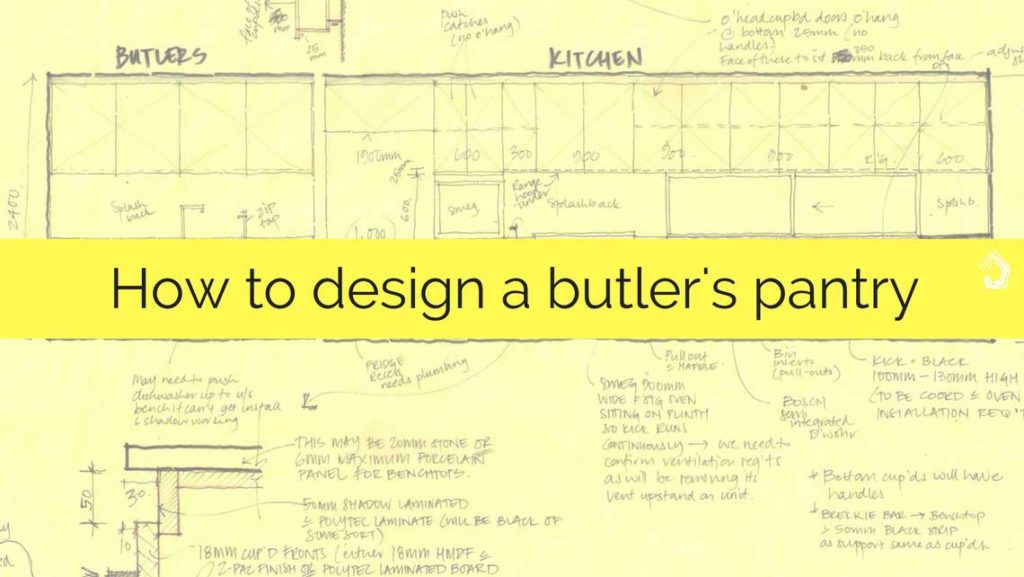
A butler’s pantry used to be a luxury item. I remember we put them in the penthouses of the last Mirvac project I worked on in 2007 (just before my son was born!), and everyone was “Ooooo … Aaaaahhhh”. Even earlier than that, I recall including a concealed area of bench-space and walk-in-pantry in a renovation design done in 2006, because we had this dead space at the end of the kitchen. It was and continues to be, such a hit for the homeowners.
And now, butler’s pantries are making their way into most homeowners’ lists for their family homes.
So what is a butler’s pantry and where did it come from?
History of the butler’s pantry
According to Apartment Therapy (in their the brief history of the kitchen pantry), the pantry itself started as a freestanding cupboard, and then grew to a more dedicated, built-in space, continuing through to the original butler’s pantry. The blog states:
“The word “pantry” comes from the Old French word “paneterie” meaning from “pain”, the French word for bread. In medieval times food and supplies were stored in specific rooms: meats were stored in a larder, alcohol stored in the buttery and bread was stored in the pantry.
The butler’s pantry was traditionally used to store silver, serving pieces and other kitchen related items. Because the silver was kept under lock and key in the butler’s pantry the butler would actually sleep in the pantry to guard against thievery.”
I remember the kitchen in my childhood home (when I was really little). It was a room – with an entry at one end, and a servery window into the formal dining space. The servery had shutters on it.
Basically, my mum disappeared into the kitchen to cook. The food was served through the opening. The mess and smells were shut away, never to be seen! It was tiny, with not much space between the two galley-style benches. That was then.
This is now. As our homes have become more open plan, and our kitchens more heavily integrated with our living areas, our kitchens have been increasingly put on display. Whilst this is great for connecting us with living and entertaining in our homes, it’s not great if you’re a messy cook, have messy family members, or don’t get to clean up straight away after each meal or prep-time.
Geeze, I think of the speedy exits we sometimes (usually) make out of our home … dishes get thrown in the sink, and a quick swipe done across the benchtops, and you cringe when you arrive home and remember that’s how you left it!! (or is that just me?) Worse still is when a surprise guest arrives home with you!!
Over the years, we’ve seen walk-in pantries – which can be as simple as a corner cupboard with some floor-space inside the door and L-shaped storage … through to concealed areas of bench-top that enable appliances to be left out permanently without being ‘on display’. And now we’re moving into butler’s pantries which are almost like second kitchen spaces.
Some homeowners I speak to lust after a butler’s pantry as a must-have. Others are not so sure why they’d be useful.
So what can you use a butler’s pantry for?
Walk in pantry on steroids
That corner cupboard I mentioned previously … with the L-shaped shelving, the door on a 45 degree angle, and a bit of floorspace inside the cupboard … I’ll be honest – that version of the ‘walk-in-pantry’ is my pet hate. In my opinion, they are a lazy way to deal with a corner in a kitchen, and become a dumping ground internally that never works well.
Instead, create a butler’s pantry that gives you straight pantry shelving, no corners, that you can walk in and access easily. Pantry shelving only needs to be 300mm deep, and you can get away with 1,000mm access space / circulation in front – so this doesn’t chew up a lot of floor space.
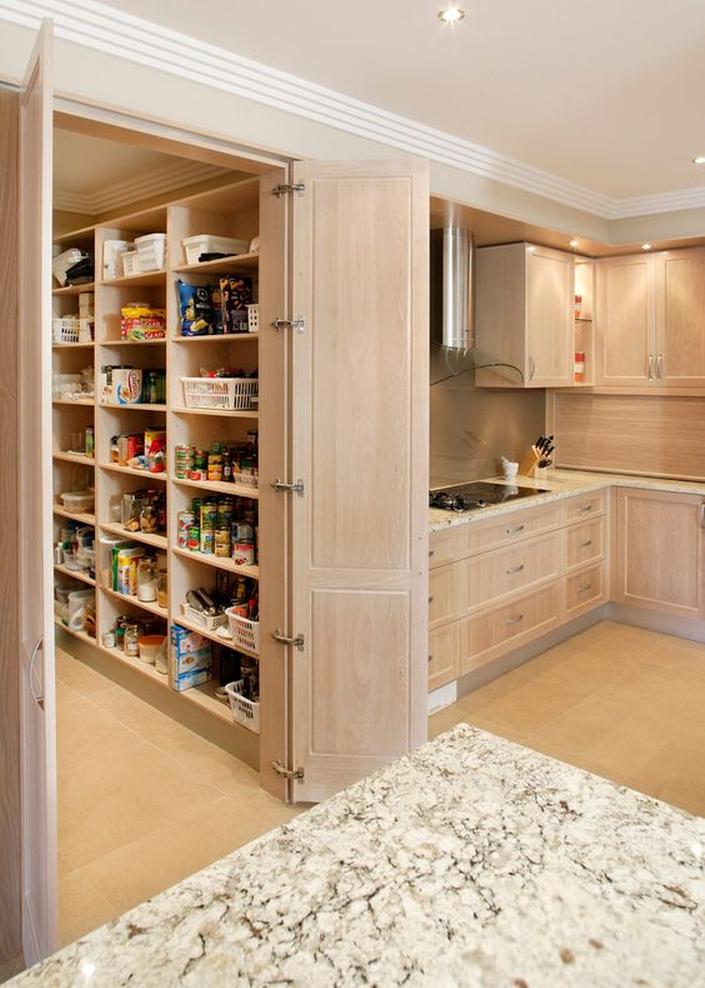
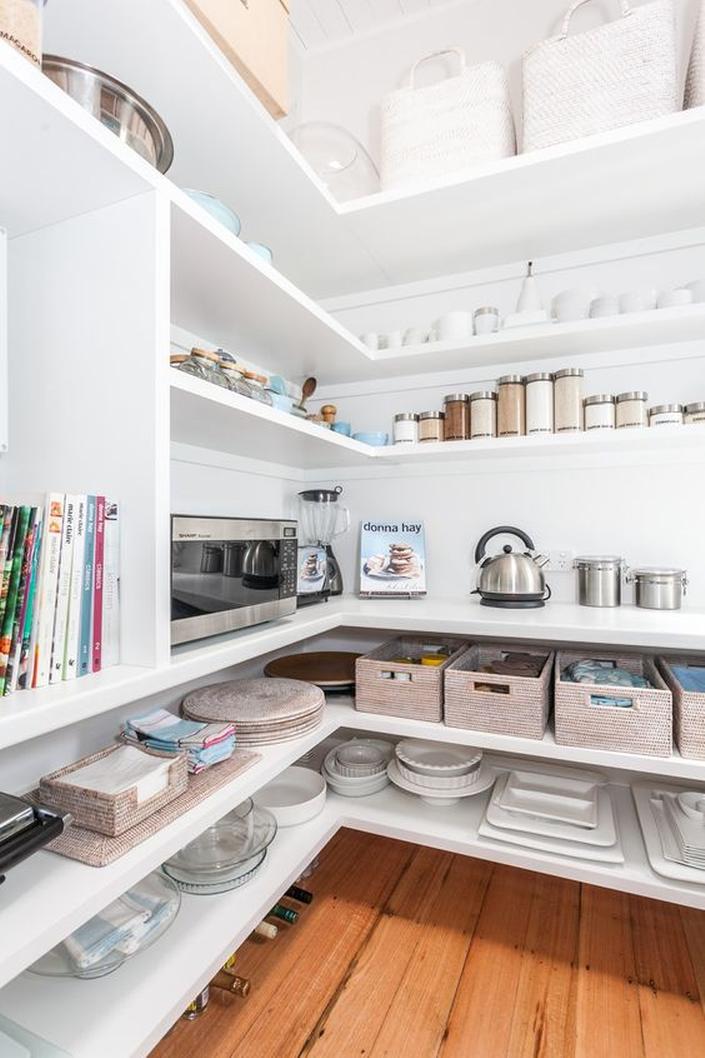
Messy kitchen prep area or breakfast station
The next step up I see is a space which has pantry shelving, as well as some bench space for prep and appliance storage and use.
It can be great to provide a space where you’re able to have the toaster, kettle, mix-master, thermomix, etc, all out on the benchtop permanently. During busy prep times (like brekkie), a space like this can help several people be in the kitchen at once, and not be working over the top of each other.
Bench-space can be 600mm deep, with cupboards or open shelving below for easy access. Remember power requirements and provide outlets for the items you’ll want easy access to.
And if it’s where tea and coffee is regularly being made, provide a home for those items, plus mugs / teacups.
Some homeowners like to provide a second sink within this space – and a luxe choice can be the inclusion of a Zip (or similar brand) tap which does filtered / boiled / sparkling water direct from the tap. That’ll do away with your kettle completely!
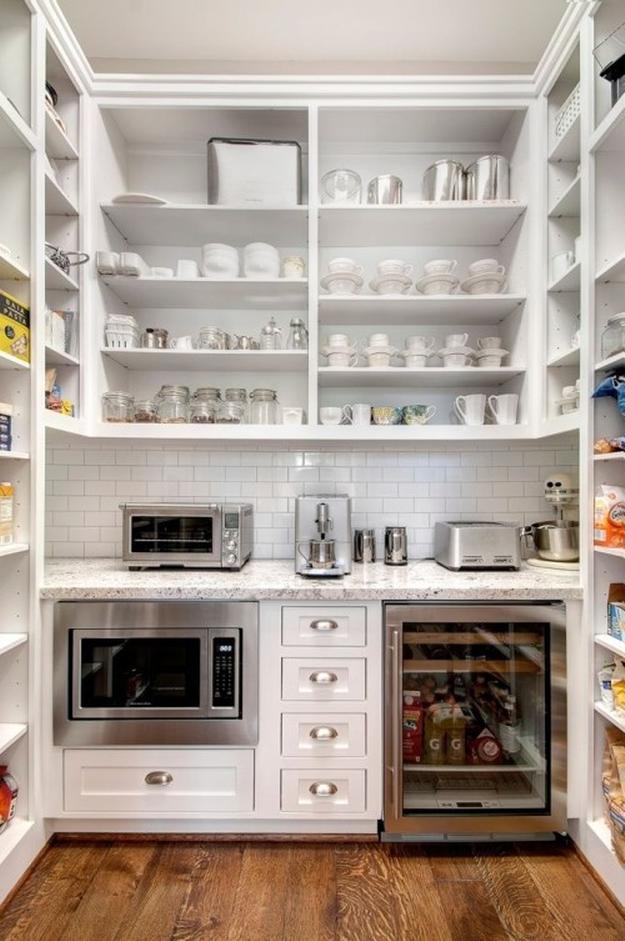
“Hostest-with-the-mostest” sanity saver
Imagine you’re entertaining. You’ve got friends over for a sit-down dinner, and perhaps you even have some catering help in the kitchen. You are the hostess with the mostest! And that means you don’t want to be stuck in the kitchen for the whole meal.
This is where having a butler’s pantry with a second dishwasher, a sink and decent bench-space, can come in handy. That mad changeover between courses means that dirty dishes can be dumped in the butler’s pantry (even loaded into the dishwasher there), and the next course delivered to tables. Meanwhile, your ‘on display’ kitchen doesn’t look like a messy dumping space … especially as friends congregate in the kitchen, or you continue your conversation with them from there as you magically produce the evening’s fare.
If you like to have a pristine kitchen, and it’s on full display to your living / dining spaces, and you’re not wanting to panic about keeping it clean all the time – a butler’s pantry like this that you can just shut the door on when required – can be a lifesaver.

Second utility kitchen
Honestly, the sky is the limit when it comes to butler’s pantries. I’ve seen versions which are almost a whole second kitchen, dedicated as a ‘butler’s pantry’. It really comes down to how you live, your budget, and requirements.
If you’re the one cooking all the time though, remember that your family and your friends will usually be in your kitchen whilst you’re cooking. So if you want to stay in amongst the action, and not have to disappear to another ‘room’, design your kitchen and butler’s pantry accordingly.
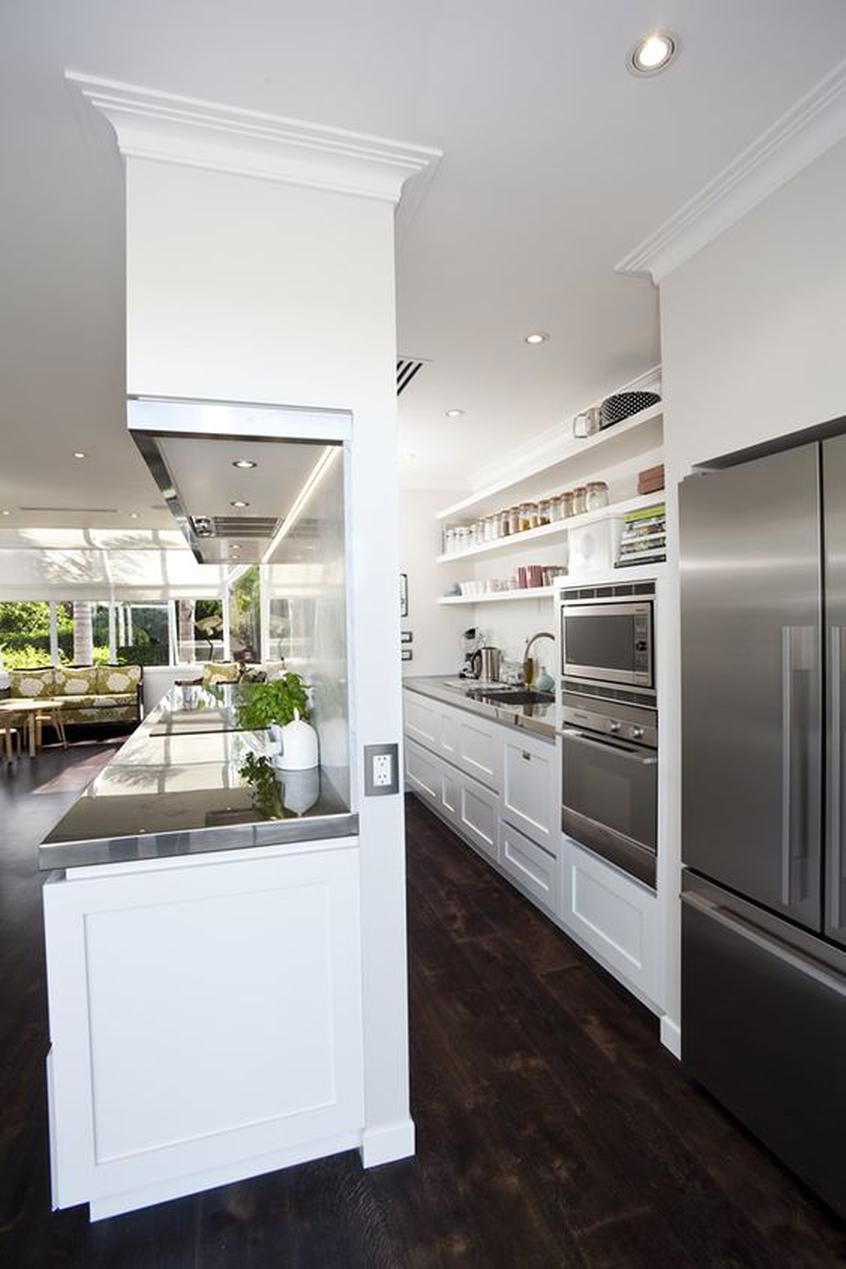
Don’t have the space? Here are some alternatives:
Sometimes there just isn’t the room for a butler’s pantry. And I believe it’s a bigger priority to have a super functional kitchen, than trying to squeeze in a butler’s pantry as well (and compromising your kitchen in the process).
Bench, drawers and shelving behind doors
There are lots of options for how kitchen joinery doors can open and shut these days.
Bi-folding doors can slide to one end – either full height, or along the top of a bench-top. Pocket doors can open and push back into gaps that accommodate them. Panel doors can hinge up.
Behind these doors, you can conceal a bench-top, with shelving and drawers, and provide your breakfast station, or concealed appliance space.
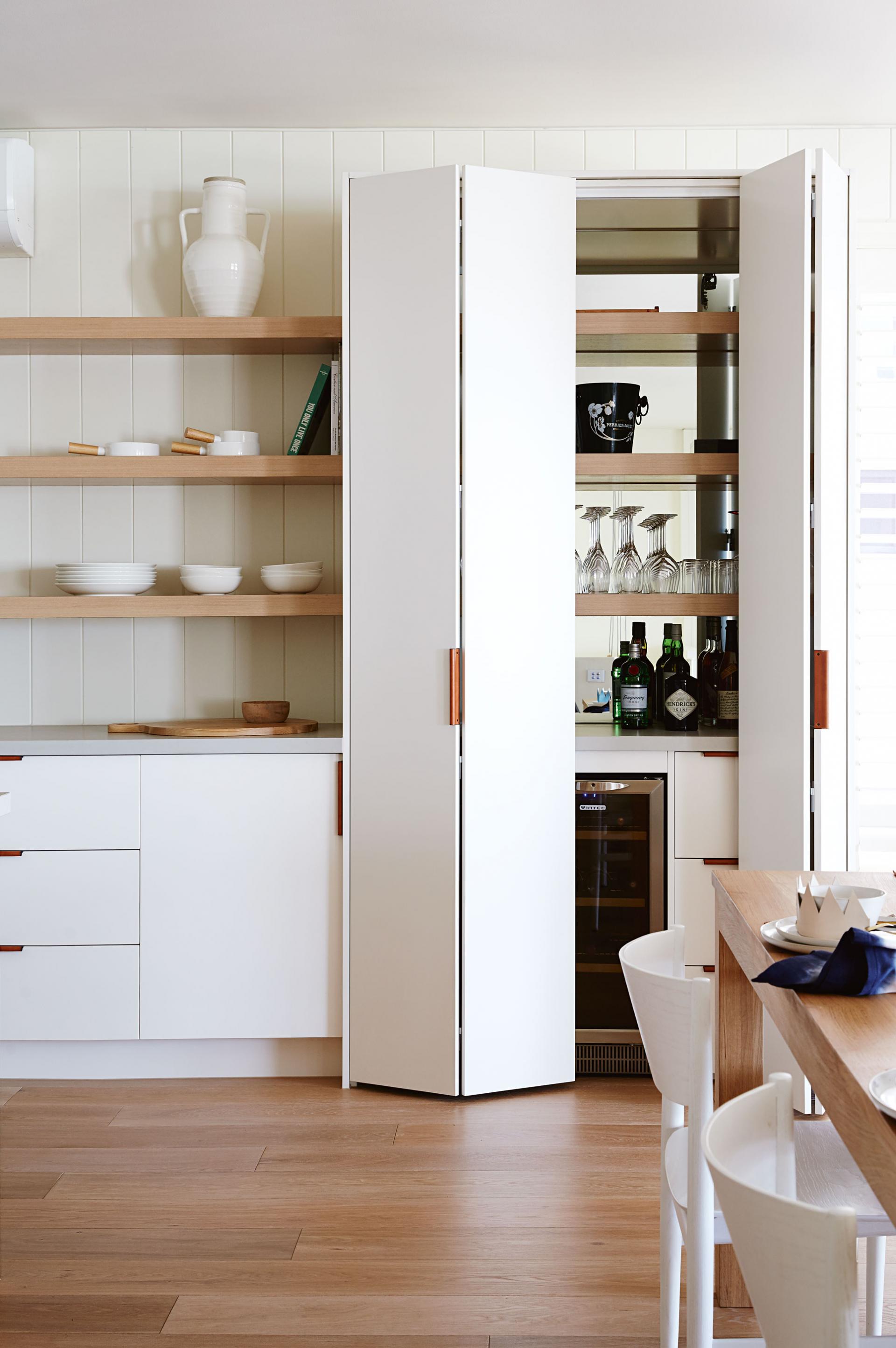
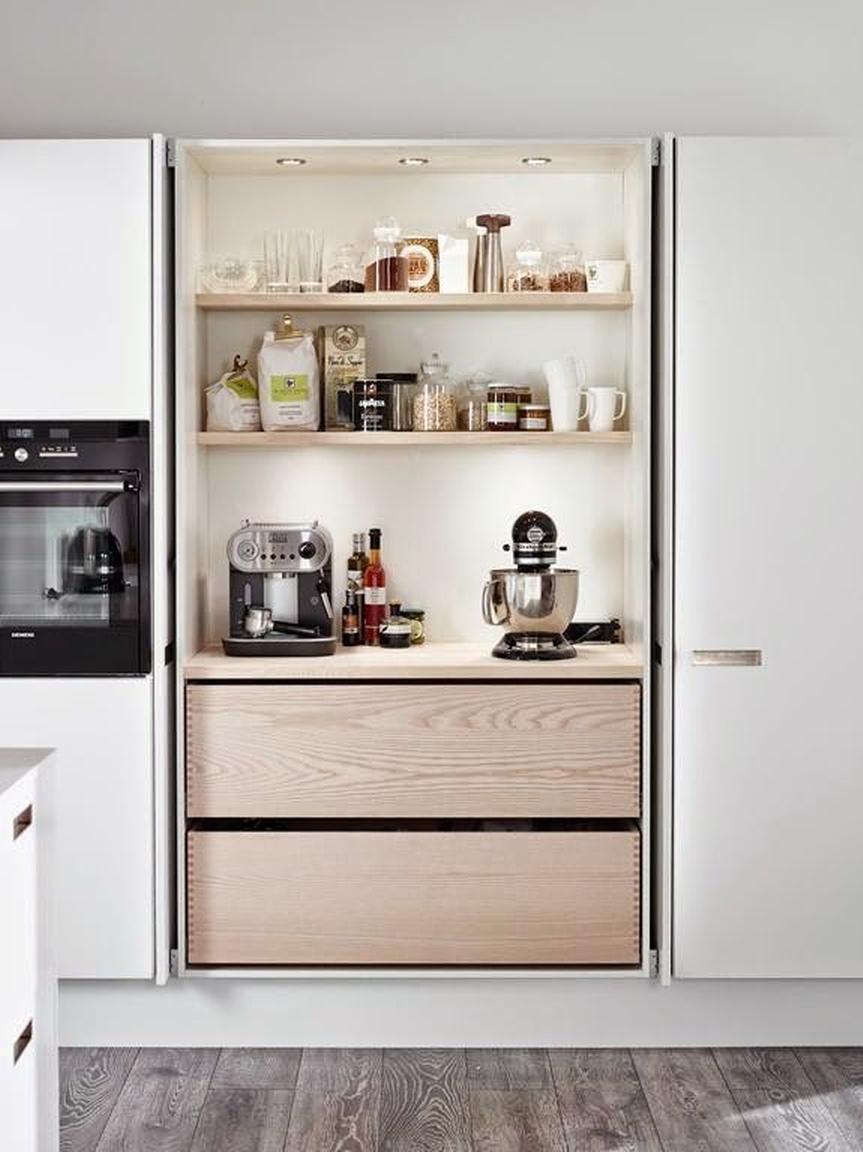
Small continuation of the kitchen you can partially screen
Can you organise your kitchen so that some of it is on display, and some of it is partially screened?
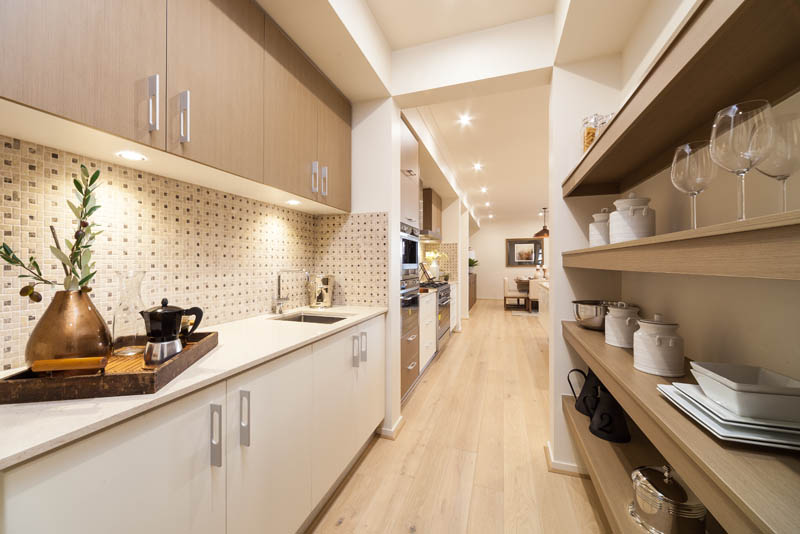
Tambour doors
I find homeowners have a love / hate relationship with these doors – but they are an option to create that tuck-away space for appliances with a solution you can buy off-the-shelf. They roll down from the top usually.
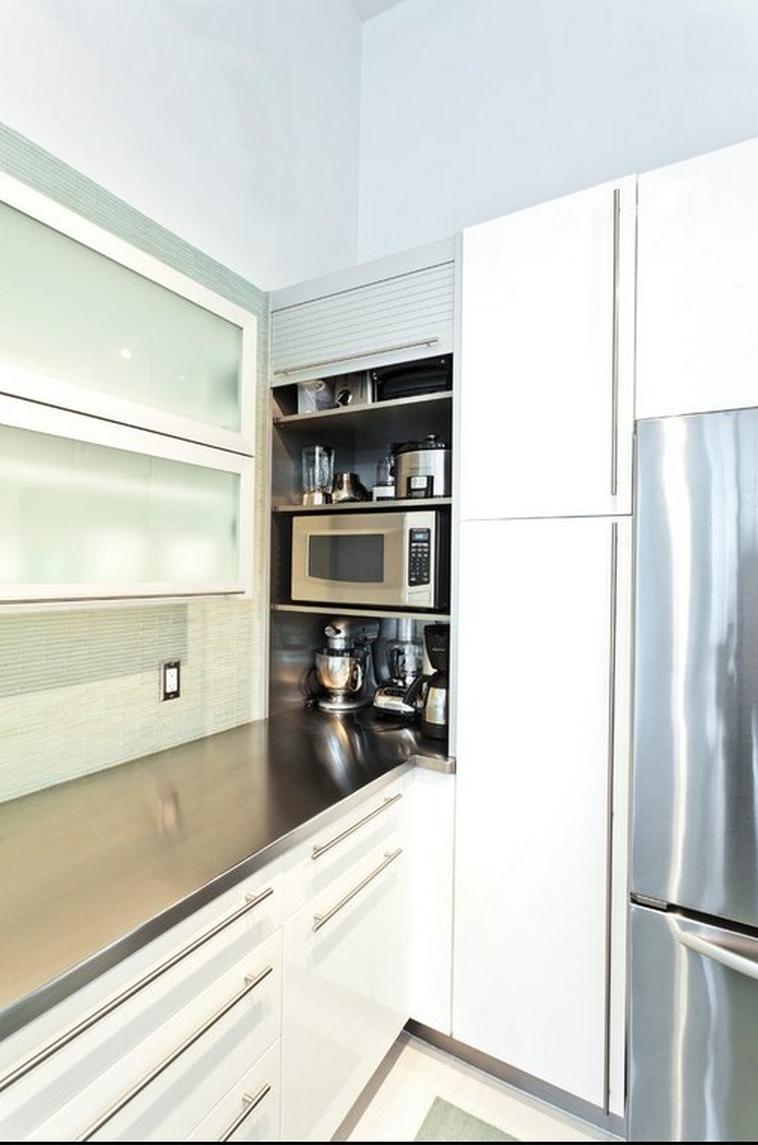
Corner cupboard that works
I’m generally not a fan of below-bench corner cupboards. They can be made more functional with a storage insert / lazy susan style insert that gives you access to everything in them.
Above the bench however, you can create an appliance cupboard of sorts. Run your bench-top into the corner, and sit a bottomless-cupboard on top. Locate your power outlets inside the cupboard. Store your toaster and kettle (or other appliances) in there. Pull them out onto adjacent bench-top space when you want to use them. Push the back in and close the door when you don’t.
My hubby even did this with a drawer in one of our renos. The drawer opened over the top of bench-space – so we pulled it open to use the toaster and kettle. He made the drawer have a small slot in the bottom, so crumbs could be swept out (always a thinker, my hubby!)
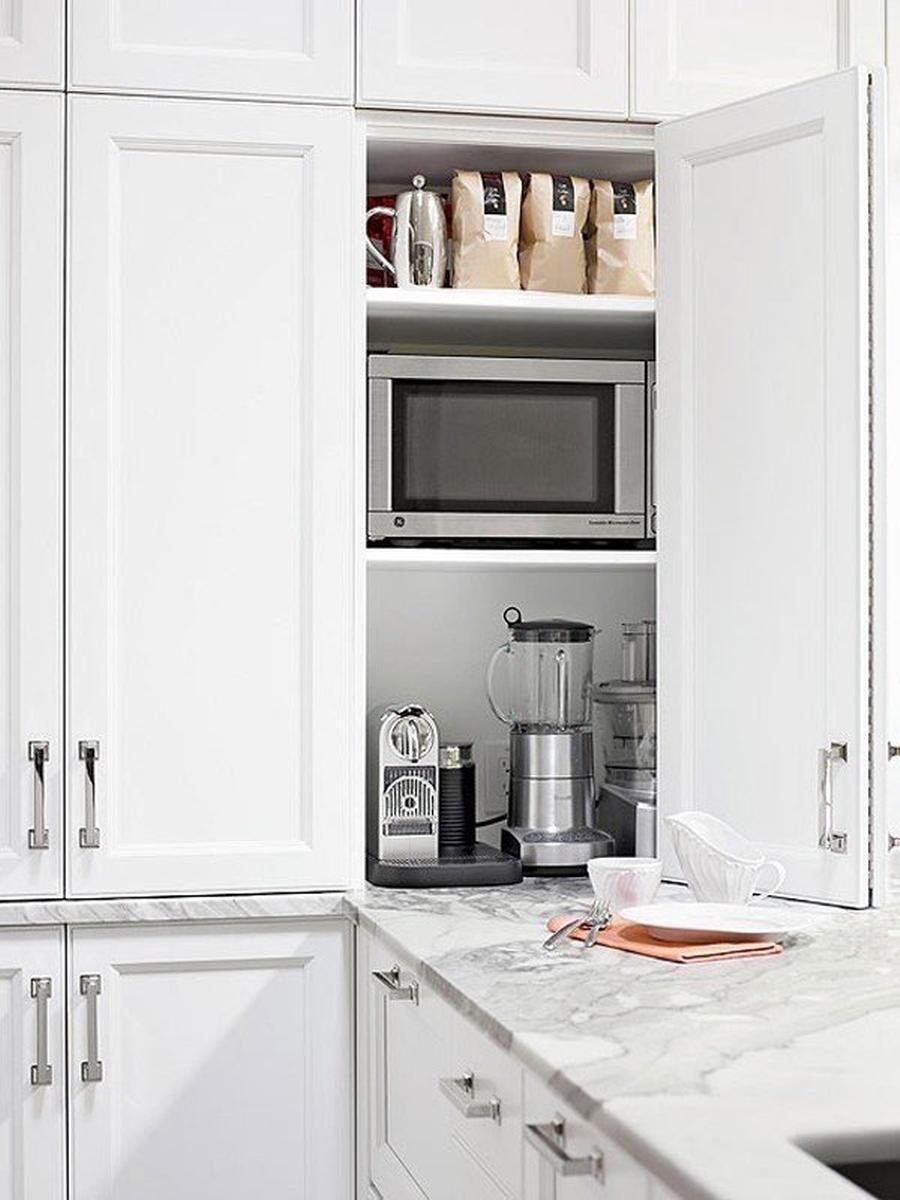
Pinterest board link
On Undercover Architect Pinterest, I have a board where I collect images and ideas to inspire how to get appliance and pantry storage working well in your kitchen. Click here to see.
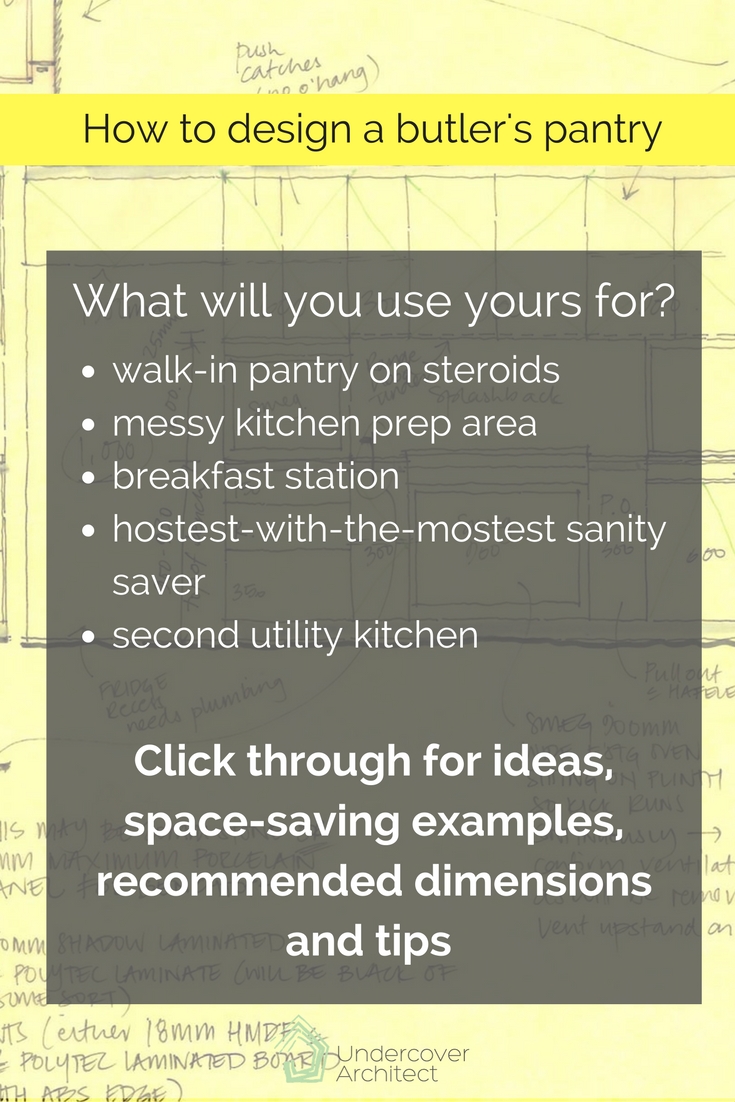
Pin this image to save this blog to your Pinterest board!
Here’s some recommended dimensions and tips
The simplest arrangement for butler’s pantry that I’ve been using in projects is where the space is a continuation of the kitchen.
- Bench-top, with cupboards below and above.
- Bench-top is 600mm deep.
- Pantry shelving opposite, which is 300mm deep.
- Allow a space of 1050mm minimum between (ideally 1,100 – 1,200mm).
- You can use it as a walk-through space to your laundry (as per the Andersons’ project)
- I recommend not making it a walk-through space from the garage. It’s tempting to think it’ll be great to take your shopping in that way but happens instead, is you bring shopping in, put it on the floor where it’ll be unpacked … and then have you, the family (potentially with all their gear) stepping over, trying to get in the house. Rushing, boisterous children make for squashed groceries.
- Consider what you’ll have in it, and use it for, and allow sufficient storage space, plumbing and electrical requirements.
- Also consider natural light and ventilation. You’ll spend more time in there than a standard walk-in-pantry, and it won’t feel great if it’s dark and stuffy. If you can’t get a window in there, consider a skylight (if not on the lower floor of a 2-storey home!)
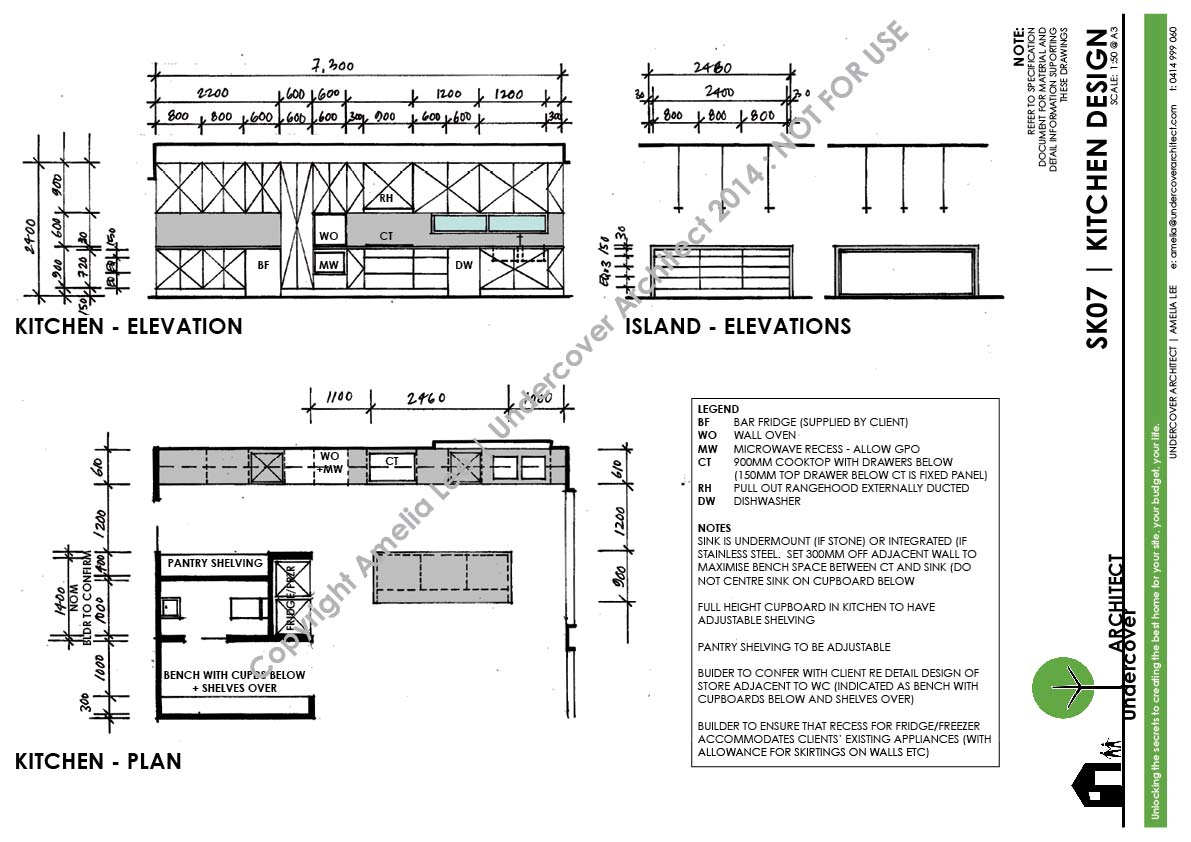
Over to you!
Is a butler’s panty on your must-have list? Or can you not see the reason to have another kitchen space like this. Perhaps (unlike me) you’re just awesome at keeping your kitchen tidy!
Comment below – I’d love to hear your thoughts.
Other blogs you may find useful …
This one is my Kitchen Design Masterclass – with all the tips and tricks for a kitchen that’ll work.
When planning a family kitchen, this is the layout to avoid.
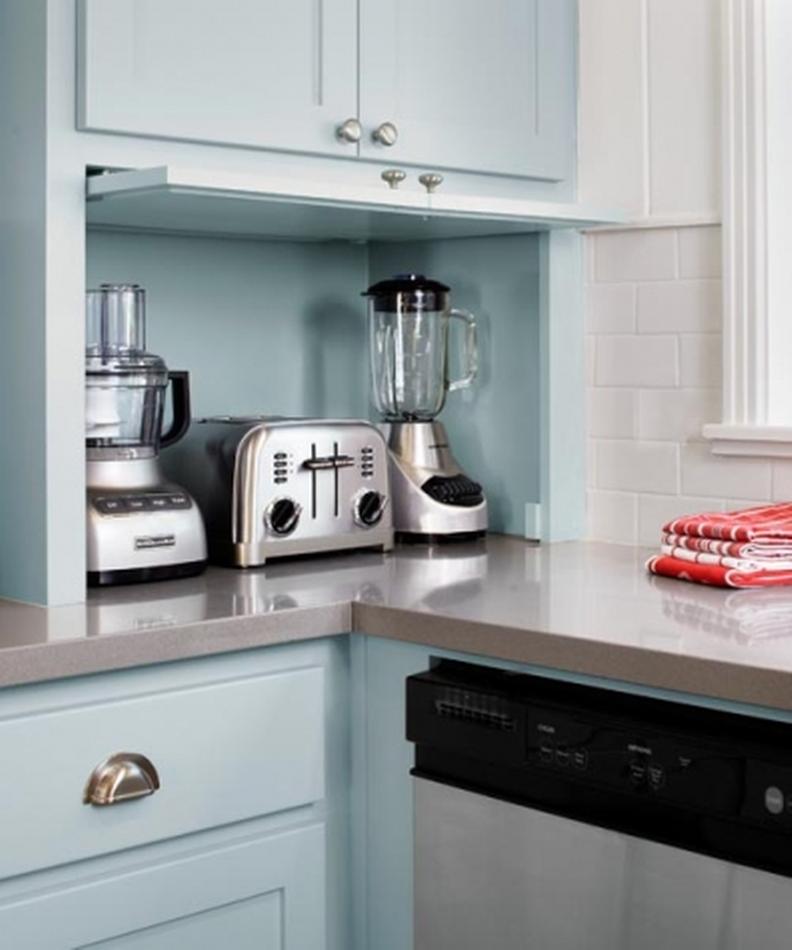
 With over 30 years industry experience, Amelia Lee founded Undercover Architect in 2014 as an award-winning online resource to help and teach you how to get it right when designing, building or renovating your home. You are the key to unlocking what’s possible for your home. Undercover Architect is your secret ally
With over 30 years industry experience, Amelia Lee founded Undercover Architect in 2014 as an award-winning online resource to help and teach you how to get it right when designing, building or renovating your home. You are the key to unlocking what’s possible for your home. Undercover Architect is your secret ally
Perfect timing for me as I try and plan (early stages) of renovated floor plan – including adding a BP.
Would you consider a sink as a must have in there? At this stage I have planned for mostly open shelves, maybe a cupboard, bench space and a wine fridge. Its more for storage then a prep area.
Hi TG – thanks for your comment. I’m glad this has come at the right time for you!
If you’re planning on having your toaster and kettle in there, then I would include a sink. If not, it’s probably not necessary. I personally would always arrange it so I could put my toaster and kettle in there though … and have bench space for other appliances I like to use to be out permanently.
Hope that helps! Best wishes with your planning,
– Amelia, UA x
Great to see, thank you, as we are about to begin planning. Thoughts about a pantry as a walk through to the laundry – don’t want to be carrying dirty ‘sick, messy kids’ laundry – past a clean food prep or storage area 🙁
Hi Sam,
Thanks for your comment, and glad it’s helped you. A lot of homeowners like having their laundry near their kitchen so they can keep an eye on washing and get loads out as soon as done – rather than having it tucked away. In a lot of other countries, laundries are right next to, or actually in, the kitchen. Sick, messy kids gear going past food storage though would not be great. Perhaps a laundry chute would help if you’re building / renovating a two storey home?
I think having a laundry which doubles as a mud-room (or has a mudroom extension) is super useful for families – so kids messy sports gear, wet swim gear etc, can get dumped in there. And if you’re having a mudroom, you want it to be located somewhere between your garage entry, and your interior.
Best wishes with your planning,
– Amelia, UA x
I really want to integrate a hidden pantry behind a wall of cabinetry with a full height pair of doors opening inwards to reveal a room behind. I’ve struggled to find a cabinetry solution as no one makes cabinet hinges that open inwards and any other hinge will likely require a thicker door and more robust frame than the cabinets either side. Any ideas?
Hi Michelle,

Thank you for your comment. Yes, I’ve not seen cabinetry doors like that. Hettich, Hafele and Blum are the manufacturers of most hinges / cabinetry hardware that gets used in kitchens – so perhaps give each of them a call to see if they have a solution.
Could you instead do a bifolding door solution (as per the image) – it wouldn’t take up as much room external to the pantry.
The other option is to look into door hinging solutions such as a pivot hinge. Then you may be able have it operating with the pivot hinge top and bottom, and not need the chunky side frames like a standard door does.
Hope that helps!
– Amelia, UA x
Hi Amelia,
Thanks for such an informative post (esp. recommendations) – I’ve passed it onto some of our clients (it wouldn’t go amiss for some designers to read it as well).
Prediction over the next few years : All the kitchen functions will move into the Butler’s pantry and we’ll be back to an enclosed kitchen with maybe just an island outside !
Hi Robert,
Thanks for your kind feedback and for passing it on. Yes, we can take the open kitchen + closed kitchen thing too far! I think there’s a balance in getting some great, functional storage and bench space for those regular activities in the kitchen that you can quickly close the door on when needed, or is tucked out of immediate view. But if you want to be connected to your family, it’s really hard to disappear all the time into a closed space (just so everything else stays tidy!). And my hope is also that we’ll all be a bit kinder to ourselves and each other about having a messy house when friends come over 🙂
– Amelia, UA
Hi Amelia, just need advice for my kitchen. Building a new home and having some concerns with the layout of my kitchen. Is it ok for me to email you the plans and ask for your opinion?
Hi Jenny,
Unfortunately we can’t individually review drawings in that way. We’re opening up the doors to our “How to Get it Right” course really soon (in the next week) and it provides the opportunity to get your questions answered, and your floor plans reviewed. You can find out more information here >>> How to Get it Right
– Amelia, UA
Hi Amelia
We have a 137 cm x320 cm pantry off the kitchen we would like to make into a butler’s pantry. Toaster, coffee, blender, small bar sink. Plus pantry storage of dry goods. Is this sufficient width? Would 90 cm walk way and 45 cm counter work if most appliances and sink are right inside the pocket door?
Hi Emma
The dimensions are super tight, but may be suitable if you only ever plan on having one person in there at a time. Ordinarily, you’d allow 1050mm – 1200mm for the walkway, and a 600mm bench depth.
– Amelia, UA
… please update to include the Singapore/KL wet kitchen dry kitchen concept. This would give much more utility to the butlers pantry concept giving actual value for money, not just flash… and be greener… reducing the both the air vented out during cooking…and heat added to a air conditioned room .
Hi Cjared,
Yes – that’s a great option – although in my experience quite different to how most homeowners use a butler’s pantry. I’ve found the everyday kitchen + smelly-cooking-outdoor kitchen approach which is also common in Asian homes, is sometimes used here by families with that heritage. James Russell explored a version of this in his own home at Brookes St (http://jrarch.com.au/)
– Amelia, UA
Hi Amelia,
I am about to do a butlers pantry existing space attached to the end of our galley kitchen and am trying to work out what to put in it, I was hoping not to move the dishwasher or put in a sink as we already have a big double sink in the main kitchen and the dishwasher there.
My key priority is to not have dishes everywhere on the bench in main kitchen & I do like to have some appliances out.
Do you have any must haves for the space & What is the best food storage ideas for ease of access and as little dusting/cleaning as possible I do like the look of say 3 visible floating shelves but am worried about the open dusty scenario.
Hi Keriann,
Great question, and love that you’re thinking about your design like this. I really recommend listening to this episode of the podcast, because it answers your questions there.
– Amelia, UA
Does a Butlers pantry bench top and splashback need to match the main kitchen.
Hi Kerriann,
It doesn’t, but it’s preferred to have it working with your overall finishes so your home design feels more holistic. I’ve seen lots of instances where homeowners try to save budget in the butler’s (and I’ve done this in my own projects too), so used Laminex on the benchtop in there, plus simple tiles on the splashback. The colour scheme still works with the main kitchen, and the home overall, so it doesn’t feel jarring when you walk in. In another design, I flipped the colours in the butler’s. So the kitchen was mainly white with some black trims, and the butler’s was mainly black with white trims … which meant we could play with materials a bit.
Hope that helps!
– Amelia, UA